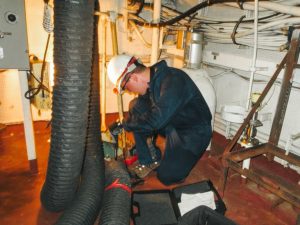‘TRACERS’ to provide long-range, continuous monitoring of environmental gas data from stationary and wearable sensors to enhance situational awareness and safety
Fairborn, OH – March 31, 2025 – Gas-free processes, often used in ships and storage tanks, involve removing dangerous and explosive gases to ensure safe entry or operations. Current Naval shipyard gas-free engineering processes are labor intensive and, although essential to a safe working environment, constitute a bottleneck in Naval shipyard operations. This results in costly downtime for both personnel and military assets while awaiting spaces to be certified for safe entry so that maintenance and repair work can begin. The longer a ship spends in drydock, the larger the impact on the Navy’s mission to deliver on time in service of national security preservation goals.

Jeff Buckle, a gas free engineer assigned to Puget Sound Naval Shipyard (PSNS), Bremerton, Washington, performs “drop testing” of a tank prior to entry and inspection as part of his required 300 hours of on-the-job training to earn his gas free engineer certification. Photo courtesy of Navy Safety Command (DVIDS).
This challenge is compounded by the lack of continuous data for safety monitoring and analysis, increasing the risk of incidents such as fire, as well as fatal injuries to workers.
TRACERS, the Telemetric Reporting of Atmospheric Conditions for Efficient Repair Schedules system, addresses these challenges by providing long-range, continuous monitoring of environmental gas data from both stationary and wearable sensors. Under development by Aptima and partner BlackOhm, this cloud-enabled system utilizes a FedRAMP-compliant sensor fusion framework to ensure secure, real-time data transmission and integration, enhancing situational awareness and safety. TRACERS will significantly improve maintenance throughput and safety by reducing the manual task burden on gas-free engineers, enabling longitudinal tracking of environmental risks, and integrating seamlessly into existing Navy infrastructures. Designed to operate with sensors already of interest to the Navy, TRACERS will facilitate a smooth transition, enhancing productivity and safety in shipyards while supporting future networked IoT applications.
The resulting TRACERS technology will support gas-free engineers (GFEs) and Navy competent persons (NCPs) by reducing the burden of manual atmospheric monitoring and enabling longitudinal tracking of environmental risks.
TRACERS is a member of Aptima’s Health and Safety Augmentation (HSA) portfolio of solutions. Our HSA solutions are engineered to enhance situational awareness and decision making in high-risk environments by integrating wearable technology, real-time data analytics, and immersive training solutions.
For more information about TRACERS, contact aptima_info@aptima.com.
Related posts
October 1, 2025 - "VORTEX" to provide safer training for dangerous missions in the U.S. Army
September 15, 2025 - Year 2 of contract to provide new framework to algorithmically match Guardians with USSF needs
August 25, 2025 - Elite designation recognizes Aptima among only ~220 certified companies out of ~88,000 in the defense industrial base


